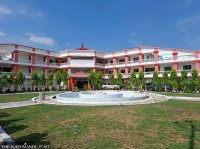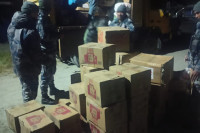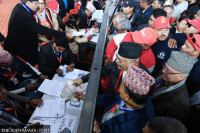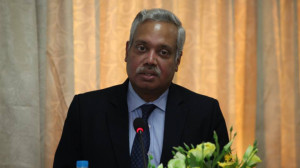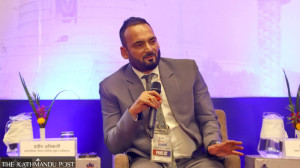National
Police ramp up CCTV monitoring
Following the launch of the Community-Police Partnership Campaign in late October, Nepal Police has attached top priority to the installation and expansion of CCTV cameras to prevent crimes and catch criminals.
Nayak Paudel
Following the launch of the Community-Police Partnership Campaign in late October, Nepal Police has attached top priority to the installation and expansion of CCTV cameras to prevent crimes and catch criminals.
Since the launch, it has covered a lot of ground. CCTVs have been placed in major public spaces across the country, especially in Birgunj, which is currently being touted as a model surveillance city.
“The installation of CCTV cameras in as many areas as possible will allow us to monitor criminal activities across the country,” SSP Uttam Raj Subedi, Nepal Police spokesperson and a focal person of the campaign, told the Post.
“Crimes can occur anywhere and we need evidence to arrest criminals and for that CCTVs will be of great help.” But the proliferation of surveillance cameras also means less privacy for citizens.
The government as of yet has not even designed policies related to mass surveillance. And this has drawn a lot of questions from critics who wonder how the monitoring will be carried out, who will do it and whether it will protect and respect citizens’ right to privacy.
According to Nepal Police records, there are currently 2,772 CCTVs placed across the country, out of which 474 are in Kathmandu Valley, with their feeds visualised, recorded and monitored through two control rooms in the Metropolitan Traffic Police Division (MTPD) and the Metropolitan Police Commissioner’s Office, Ranipokhari.
The control rooms are operated by eight officers round the clock, for which 30 officers have been mobilised who work in three shifts. The same staff in the control room of the MTPD and the Commissioner’s office also respond to distress calls at 103 and 100, respectively.
As per the plan, district police offices and the provincial police departments will have access to the footages. Nepal Police, from its headquarters in Naxal, Kathmandu, will have access to the feeds from provincial police, allowing them access to all the cameras in the country.
“The central police headquarters will work as a central loop with access to every CCTV camera in the country. Through the central loop, we can look at any place from the headquarters itself, in case of an emergency,” added SSP Subedi.
However, critics of the campaign strongly dismiss the idea of allowing the government to snoop in on their privacy.
“Criminal activities are growing nowadays, whether or not the Nepal Police has CCTVs,” said youth leader of Nepali Congress and lawmaker Gagan Thapa. “If we are watched by unidentified people and if the footage is accessed by the wrong hands, then our freedom is compromised. We must know exactly who has the access to our information and the government must ensure that it will not be misused.”
Sharing the same sentiments, Taranath Dahal, chairman of Freedom Forum, a non-government organisation, said, “Footage should not be misused neither by the police and nor by the government. CCTVs should not be used to inspect regular activities of a citizen. All the places with CCTV should have information regarding its placement so that people can know that they are being watched.”
Nepal Police, however, are less concerned about invading people’s privacy, and more about having inadequate equipment to carry out their jobs. “Our CCTV cameras are fewer in number, and of inferior quality,” said AIG Pushkar Karki, who is also the head of the Crime Investigation Department. “We also don’t have enough manpower to monitor the footage that we have gathered. We have a lot to improve in the sector of latest technologies in order to make our policing smart.”
According to Nepal Police, the campaign will be lobbying with local governments to install CCTVs in more parts of the community.
The role that CCTVs provide in monitoring crimes cannot be blatantly disregarded. These devices do assist the police in finding culprits. Take this incident for example: On November 16, police arrested 27-year old Pradeep Oli after analysing CCTV visuals of Oli planting an Improvised Explosive Device (IED), under the statue of communist leader Pushpa Lal Shrestha in Nepalgunj.
And this is not a lone incident. According to the Metropolitan Traffic Police Division (MTPD), they have fined a total of 4,571 traffic rule violators with assistance provided by CCTV footage until last month.
Nepal Police believes this is the right way to go forward and now wants to widen their reach through CCTVs. “Installation of CCTV in various places like forest areas, highways and border areas should also be prioritised, as those areas have high chances of having movement of criminals and culprits,” Chief of Metropolitan Police Crime Division SSP Dhiraj Pratap Singh told the Post.
In Birgunj, local government and concerned stakeholders of Birgunj Metropolitan City have also started cooperating with local police to install CCTVs to prevent criminal activities in the city. Local representatives have assured economic aid, with Rs1 million from member of the parliament Pradip Yadav, Rs1.5 million from Mayor Vijay Sarawagi and Rs500,000 each from eight members of provincial assembly being put together for the purchase and installation of CCTVs.
Birgunj Chamber of Commerce and Industries has also extended its support in expanding CCTV surveillance for which they have formed a ‘Safer Birgunj’ committee as well. Similarly, schools, banks and hotels in the area have also vowed to install CCTVs in their respective areas. The city has already installed four 360-degree turning CCTV cameras which can zoom upto 500m.
Because it seems the reign of the CCTVs is here to stay, freedom activists have urged concerned authorities to at least implement proper laws before rolling out CCTVs around every corner so that the public does not feel its privacy being invaded even when they are being watched.
For this, the government has a CCTV Camera Installation and Operation Procedure 2015, for private businesses and government offices. According to this procedure, everyone has to mandatorily provide information regarding the presence and surveillance of CCTV. Similarly, the law also has provisions in which the permission of respective District Administration Office or the Home Ministry is a must to install CCTV cameras.
The government’s law for CCTV installation also has a provision in which the installer should manage a storage capacity to store footage of upto at least three months, and everyone should provide the feed to the police if they ask for it. These laws, however, do not extend to mass surveillance.
The data provided by the District Administration Office, Kathmandu, shows that only 21 business sectors, five private residents and two government offices have taken permission from them. The rest are operating CCTVs without legal permission.
“We had installed CCTVs around five-six years ago, when there was no such provision of taking permission. We installed it for various security reasons and if the government had come up with such law, they should have intensified the awareness program regarding it,” said a owner of a lounge in Thamel, who preferred anonymity.
(With inputs from our district correspondent)




 16.12°C Kathmandu
16.12°C Kathmandu

